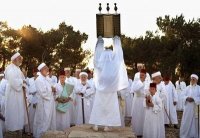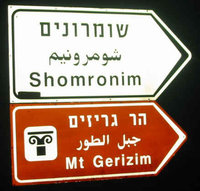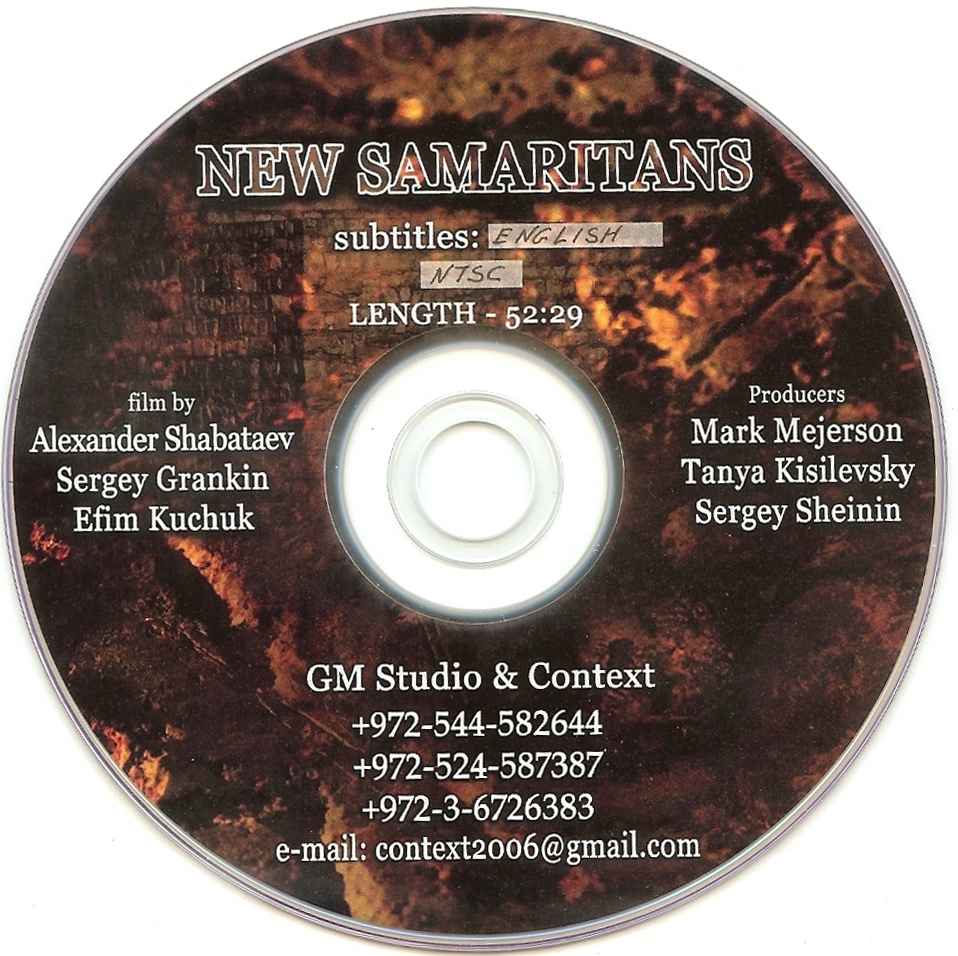~~~~~~~~~~~~~~~~~~~
Upcoming Festivals
Paschal
Sacrifice - Sunday, April 17, 2011
Pesach Festival - Monday, April 18, 2011
The Festival of
Unleavened Bread - Sunday. April 24, 2011
The Sinai Assembly Day - Wednesday. June 8, 2011
The Festival of Weeks - Sunday, June 12, 2011
~~~~~~~~~~~~~~~~~~~

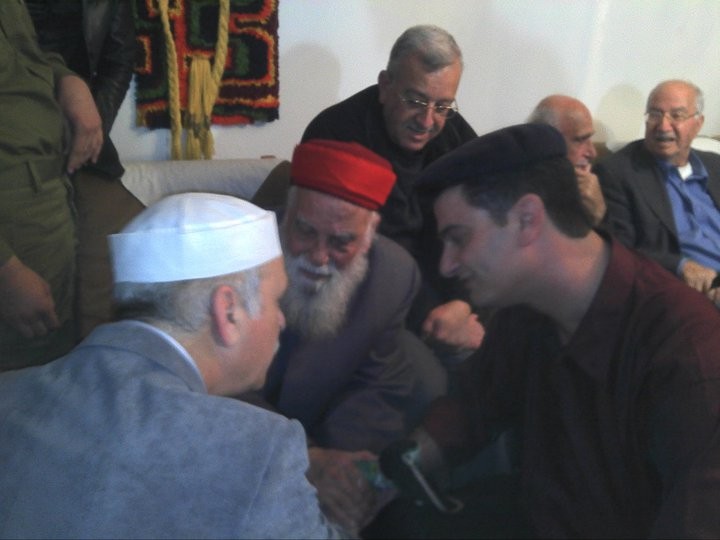
Congratulations to Osher Sassoni and Meital Sasoni
for their engagement
on March 23rd 2011
(Left photo - Meital Sasoni)
Right photo- Meital's father, Yefet
Sasoni in white hat - High Priest Aaron
in red hat, and Osher.)
Photos were taken by Sharon Yehoshua
~~~~~~~~~~~~~~~~~~~
WHAT IS THE DIFFERENCE BETWEEN PRIESTS OF
RHUTA TO PRIESTS OF FANUTA
The A.B. newspaper, since its establishment 42 years ago, has
insisted upon encouraging the safe creativity of many writers
among the Samaritan community, by collecting different
compositions that were never published before and sometimes by
bringing new compositions published in new prayer books, mostly
composed by the scribe himself who published a book, or when he
includes in his new book compositions of new writers. All of
these were made in order to encourage the publisher to keep
scribing and publishing and also the new writer to continue
composing.
Part of the publicity in A.B. is by bringing compositions that were
made for singing before the worshippers - they are compositions,
poems and hymns that are made for happy occasions or sad
occasions. It is rare that such compositions will be included
in a part of the prayer books, and because of that A.B. became
the only stage that is before the new writers. This is like a
mutual favor for both sides, they are giving their compositions
to A.B., and the newspaper is giving them a stage that helps
their composition to be in front of the eyes of all members of
the community who really like to read them with loud voices.
They read, they are impressed, they criticize - and by this the
writer enjoys double publicity of his composition and also from
the feedback of the readers. Those enjoyments encourage the
authors to continue their authorship.
In turn the editors contribute their part by beautiful layouts
in the A.B., sometimes shortening long lines, in order that the
composition will not miss its beautiful frame, or by correcting
spelling, and sometimes by correcting the writing by replacing
words that don't exist, or corrections of style that assert
information in the wrong regard.
Frequently we are receiving complaints from new writers about
changes that are made by us in their compositions. If in fact
they themselves saw the corrections, or somebody else [took care
to stimulate them] notified them of the editors' corrections -
what can we say?
It seems the publicity of their compositions in A.B. increased
their self-evaluation in their own eyes, until they wondered how
the editors dared to correct their compositions.
They always add threats that they will not publish any future
compositions in A.B., or at least they consider that. There is
not any sense to be in distress because more than the cow wants
to give milk the cattle want to suckle. In this case the cow is
the Editor of A.B.
The Editors explain that they see these corrections that they make
to the new compositions as both right and obligatory and for the
favor of the writer. It is hard for us sometimes to resist the
temptation to publish the composition as it was written, and to
put the writer to shame. However, if we would do that we will
hurt our role as Editors who insist on a nice presentation of
the newspaper that continues to be a source of pride to the
community. We also consider how the writer will be presented
before the eyes of the next generation that never knew our
generation. Don't judge us wrongly, we don't change the spirit
of the writings. Every composition continues to
identify its writer, not to mention that every writer repeats
many times his own style of writing which will be his
identification before the next generations.
Recently in one of the hymns that was published in A.B. we
found its writer giving our priest the title of those who wear
the Urim and Tammim, exactly like that. In another hymn they
are called "incense burners." Since we don't always have the
time to show the writers the mistake before publication, we
ourselves make the necessary corrections that these titles will
be phrased in the form of a wish towards the end of days.
These two titles fit the period of the days of goodwill [Rhuta],
and they are not valid to the time of hiding faces started [Fanuta],
in the year 261 after the entrance of the people of Israel to
the Holy Land. These two titles, those who wear the lights of
completeness, and burn the incense [in regard to the priests]
were valid in the days that the tabernacle of Moses, the first
tabernacle of the people of Israel existed. From the second
year of their presence in the Sinai desert until the year 261
from the time of their entrance into the land. For three
hundred complete years the tabernacle worship was active until
it was hidden by the Almighty. Since the time it was hidden,
the worship of sacrifices on Mount Gerizim was ceased. The
temple and its utensils, including the lights of completeness [urim
and tammim] and incense burners were hidden until the end of the
days when the temple would be rediscovered and goodwill for the
people of Israel would be in effect a gain.
It was the Rabban Yusef ben 'Aazzi, of the late 13th century that
showed the difference between a priest of Rhuta to a priest of
Fanuta. The Rabban Yusef was a high priest in office in
Damascus who arrived in Nablus in the year 1290 CE to be the
high priest of the Samaritan people near Mount Gerizim. There
he stayed in office as the high priest until his death in the
year 1308 CE. Most likely he was the one who invented the style
of praise hymns [Yishtabach] because there are no hymns in this
style before his time. He also wrote two important compositions
that we sing loudly on Yom Kippur: Eh Il Re'om Wanon, God of
Mercy and Compassion, and Yam Arremmem, [ = Sea of Mercies],
during the afternoon prayer and sunset prayers on Yom Kippur.
In those two compositions Rabban Yusef mourns the disappearance of
the tabernacle and days of goodwill. He called them "the days
of complete enlightenment" and "the days of burning the incense"
and "the days of lighting the candles" and "the days of the pure
table." Regarding the sacrifice, in the days of goodwill, and
who offered them he said in an inarguable expression, "no priest
is in charge [Ne'amanim], and we have no more sacrifices." We
are always laughing to ourselves frequently about those
worshipers who make their voices louder, especially in this
verse, because it actually means that they criticize the priests
of our days - although they understand the word "Ne'amanim" as
though it is in regard to honesty or belief. However, this is
not the meaning of the word. The Rabban Yusef himself was a
descendant of the glorious family of the priests, the sons of
Pinchas, the grandson of Aaron the first priest who wore the
Urim and Tammim [lights of completeness]. He meant in the word
"Ne'amanim" in regard to taking charge and responsibility and
fulfilling the role as Moses was described by the Almighty in
that "he is faithful in all my house." [Numbers 12:7].
Therefore, "Ne'amanim" in this regard was connected by the
Rabban with the reality of the tabernacle worship. Priests in
charge, according to him, are those who are responsible for the
worship of the tabernacle and its utensils, among them the high
priest who had the sole right when the tabernacle existed to
wear the lights of completeness, and the priest that was in
charge of the worship also served as the burners of the incense,
Aaron and his sons. In this way the Rabban Yusef emphasized the
clear difference between the priests of Rhuta to the priests of
Fanuta.
The later are not in charge of any utensils from the utensils of
the tabernacle because the tabernacle was hidden and they are
not offering sacrifices anymore.
The only sacrifice that is not connected with the worship of the
tabernacle, the pascal sacrifice, continues to go on and be
offered on Mount Gerizim, but this sacrifice is a sacrifice of
the people and their status when they offer it is like the
status of the priests. This is why the editors corrected the
line that described the priests by ancient titles to be written
in the form of a wish that they will someday wear the lights of
completeness.
A.B. Services
~~~~~~~~~~~~~~~~~~~
Will the Mount Gerizim Barrier Stay?
The entire Samaritan community is breathing a breath of great
relief because the checkpoint at the gate of Mount Gerizim from
the direction of Nablus was installed once again, following the
demand of the Samaritan elders in the Mount Gerizim community.
Negotiations with the highest summit of the Government of
Israel caused the change of the decision. Today the barrier is
active more strictly in checking than previous checks were.
There are some who complained before the removal of the
barrier, and today some are complaining about doubling the
checks. However, all agree that without the existence of the
barrier there is a risk of reducing the security among the
members of the Samaritan community and their Palestinian,
Israeli, and foreign guests. Today there is no access of non-grata
professionals and those who asked for this by their
identification at the gate. Today the access is only possible
for professionals that are listed on the agreed list by the
civil administration, the army, and the representatives of the
community. Tourists and Israelis can freely visit Kiriat
Luza when they come through the Southern road from Jerusalem and
the plain. We have been ourselves blocked more than once when
we travelled into the neighborhood on the mountain by a military
vehicle and we were permitted to go on only after our identity
was checked. With such an uncomfortable situation the feeling
of security and the knowledge that we are protected is better
than being insecure by the fact that Kiriat Luza without the
barrier is under the mercy of unwelcome guests.
However, it seems that the return of the barrier is not final. In
a reply to the application of the deputy minister for the
development of the Negev and Gallil, Knesset Member, Aiub Qarah,
the Bureau of the Minister of Defense, announced affirmatively
that the Samaritan barrier was returned back, although there was
no intention to leave it, but in general many barriers in
Samaria were removed as a result of the improvement of the
secure situation, and among them there is an intention to remove
the barrier of the Samaritans. With this, the Bureau of the
Ministry of Defense announced that before they will remove the
barrier, they will send the Samaritans an organized
announcement.
Yefet Tsedaka co-editor of A.B. the Samaritan News made his best
efforts to fulfill the demands of the Samaritans that the
barrier would not be removed. Some very severe security
situations that happened recently in the region strengthened
this demand. Yefet clarified to the summit personalities of the
very senior administers of the government, and in his
application it is emphasized that the barrier helps the
Samaritan neighborhood on Mount Gerizim so that it will not be
crowded by irresponsible visitors and prevent them from
polluting the holy places of the Samaritans: in the synagogue,
in the neighborhood, and on the top of the mountain. As a
result of his application it was ensured as of late that the
barrier would not be removed for a long time.
A.B. - The Samaritan News
~~~~~~~~~~~~~~~~~~~
THE HONESTY OF MOSES
In the next Torah portions we see a detailed description of the
establishment of the temple and the contents within it, provided
with an exact description of the donations and the sums of money
that God ordered for this establishment. The Almighty commanded
a collection from every person in the amount of a half shekel.
At that time the number of the Sons of Israel was 603,550 males
over the age of 20 years.
It means that 301,775 shekels were collected. Moses detailed for
us the way that every donation was brought for use in the
process of establishment of the temple, for example by the
pillars, the straps, the hooks, and the covers. Moses details
the use of gold, silver, metal, wood, cloth materials, leather,
and precious stones that were collected by ensuring that every
single gerah that was given be used towards the building of the
temple, and not to his private and secret bank account... This
thing is a wonder in our eyes because Moses was very honest and
nobody mistrusted him. If he were mistrusted, why would he
detail in public all accounts and the small details in regard to
financing the temple? The answer to this teaches us that there
are two directions that characterize personal integrity.
Not only that, but other people are committed toward the positive
judgment, but at the same time I am also committed to prevent
myself from being in a situation that could allow others to make
wrong conclusions towards deeds that I do. Too frequently we
hear people saying "I don't care what others think about me. I
know that what I do is the right thing."
Nonetheless, the attitude of the Torah is different. The Torah
says that also we have ambition to fulfill God's will in the
most complete way. It is forbidden to leave a wrong impression
to the people around us.
In the case of Moses he had a special need to detail in a public
forum all the invoices of the administration of public money.
After the golden calf incident and the breaking of the two
stone tablets, God forgave the people of Israel and ordered
Moses to make new tablets. Right after that the building work
of the temple started and in the hands of Moses was a complete
ton of gold and silver. The potential to steal or corrupt part
of the materials was possible, but the fact remains that Moses
was not accused of doing unsuitable deeds demonstrated in the
details that show us the honesty of Moses. With regard to his
public role as the leader of the people his awareness became
even more complicated because he knew that all eyes were upon
him. This sensitivity that is known to all of us exists in
great potency by people who are in a key position that serve
leaders of the public.
What is the meaning of a leader of the public? How are we as a
people seeing our leaders?
The fundamental demand from every public
personality is that he will fulfill his role from clear
intentions to improve the state of the public, and not to any
other interests - personal or other. By doing this, he does not
have to consider what they say about him, only in regard to the
concern of the benefit of the public.
Moreover, the honesty of conducting the public should be seen by
many, and it is not enough that he will be complete with the
clarity of his deeds and conscience before God, as Moses said
"and you must be clear before God and Israel." Despite the
greatness of Moses and his devotion to the people of Israel he
didn't win an entrance to the Promised Land, but nevertheless he
established the foundation of leadership leading the people in
the land of Israel. He did that in three ways, by his selfless
activity as a leader, by the way he told the history to the
people, and by the way he gave the commandments to settle the
land to those people who would enter the land. These ways show
us that Moses fulfilled in his life a model of leadership.
Moses serves as a personal example of how to lead the people,
and also affixing laws of justice and legal matters, and
leadership to direct the people during their settlement in the
land.
Moses describes how he initiated the establishment of a legal
system in the desert. He asked from the people to chose
personalities that he would appoint as judges and order them to
judge in justice. If they could not come to an agreement, they
would have to ask him to make the final decision. The best
preparation to the settlement of the land was establishing a
system that would take care of moral life inside the people of
Israel.
For that, Moses commanded the elected judges to
judge the people according to moral criteria. It seems that
these criteria are the foundation of the stable national life.
Also when they entered the land of Israel, the people of Israel
were commanded first to establish a legal system, the same legal
system that Moses established in the desert. The commandments,
judges that you must have (Deuteronomy 17:1) is the first
commandment in regard to leadership in the Land of Israel. If
so, it seems that Moses hints to the people of Israel that they
must see him as a model to imitate and establish a legal system
as a first priority.
What are the considerations of electing a leader? The State tries
to help us in electing our leaders by a basic law of the
Knesset. "Every Israeli citizen In the day of giving the list
of candidates that contain his name, and that he is over 21
years of age, is privileged to be elected to the Parliament,
unless the court prevents him this right by the law or he has a
final verdict against him for punishment in prison for a period
of over three months, and in the day of giving the list of
candidates it must be only after seven years after his release
from prison, and only if the chairman of the central election
committee stated that the crime of his verdict has no disgrace.
Today, we are free from the hard situation of electing a leader by
God himself who elects the High Priest. With that, I believe by
God's election of the High Priest, He places into his hands the
ability and the responsibility to be a model to be imitated.
By: Roey Tsedaka - Holon
~~~~~~~~~~~~~~~~~~~
TO LET THE DIFFERENT AUTHORITIES TO HEAR WHAT IS PLEASING
THEN IS THE WORST POLITICS THAT WILL EFFECT THE SAMARITAN
COMMUNITY IN THE LONG RUN
Despite the fact that we are trying our best to walk between the
political raindrops in our region, it is impossible not to get
wet. We insist upon a neutral position in the Middle East
Conflict despite the fact that that we are the smallest ethnic
group in the world, and due to being divided in our places of
living in regions that are under the authority of different
entities. Over one half of the community is under the
administration of Israel and the rest under the administration
of the Palestinian Authority.
More than once we heard testimonies from some members of the
community about their understanding of the Palestinian
statements that consider Jerusalem as the Capital of their
future state.
This is already in the process of being established, under the
agreement of Israel the Prime Minister of the Palestinian
Authority, Dr. Salam Fayaad, is building the first Palestinian
City called Rawabi.
On the other hand the government of Israel demands from the
Palestinians to recognize the State of Israel and the borders of
the Green Line as a Jewish State, before discussing the official
establishment of the Palestinian State. In addition, Israel has
asked for general International recognition for its Capital,
Jerusalem.
Now that almost half of us are recognized by the Palestinians
and the Israelis together, which is a very special phenomenon in
the sensitive political spectre of the Middle East, we have to
ask ourselves if this is the right step in state support or to
join the desires of either of the two sides in regard to their
political desires.
If we were counted at a million and a half, as we were 1500 years
ago, maybe we would permit ourselves more than what we have
today, maybe fulfilling desires for a separate political body,
or at least declaring our own autonomy. However, instead of
that we have to live with the reality of a community that totals
only 750 individuals, and even this number is divided between
the administrative areas of Israel and the Palestinians. It is
correct that we can translate our weakness to a potency by being
a bridge between the two sides of the regional conflict, because
it is not in regard to a mass of people but a very small public
that is trying to survive between two forces that are provoking
one another, when they are not busy making peace between them...
We must speak the truth that neither Israel nor the Palestinians
have demanded that we express identification with their
political ambitions. There is a clear difference between
Palestinian seniors who see the Mount Gerizim Samaritans as an
integral part of the Palestinian entity, to the Samaritan
seniors who state the same thing although they were never asked
to do that. When we make political statements without having
any cover of any kind or ability to fulfill them, only in order
to satisfy one of the sides of the conflict we look pathetic if
not less than that. Also in the time periods of our numerical
strength, when we had an army of our own to protect us, during
the Hellenistic period, and during the reign of the Pagan Romans
and Christian Romans, there were those who blamed us for
switching sides by declaring at various times different
identifications. Most of these accusations were baseless
insults, because under political and military hard pressures our
forefathers knew how to save the national pride and went out in
order to rebel against the enemies that persecuted them.
Nevertheless, today because of the smallness of our number, our
activity is considered only as a statement. We have to
recognize the fact that for the last three generations we are so
busy with just surviving. Currently we multiplied our number
over five times, and the excommunication from us is minor in
regard to any other society. Our survival did not derive from
our statements for or against one of the sides of the conflict,
but from keeping our national pride about what we are - An
Ancient Israelite people who preserve a special tradition and
trying to be a model of living together in divided political
regions under a condition of peace.
The former mayor of Nablus, Mr. Ghassan El Shaqah, once told us
after we told him about the establishment of an International
Peace Centre on Mount Gerizim and also about our activity of
awarding the first Samaritan Medal to Peace Makers in the region
and in the world: "Who is more suitable than you the Samaritans
to be a bridge of peace between us, the Palestinians to Israel?
You are accepted by us the Palestinians, as you are accepted by
Israel, and that is why you are the most suitable to make
peace." It seems that there is no people who want peace more
than the Israelite Samaritan people, because under the condition
of peace we are insuring our physical existence but also
flourishing in all directions, the educational, the social, and
the economical. It is clear enough if one goes around for a
moment in Kiriat Luza neighborhood and our neighborhood in Holon,
in order to be exposed to the giant step that the community made
in an economical regard. We don't have welfare cases because we
are doing well economically. Almost every family has more than
one car and our houses are comfortable.
There are even those who compete as to who is more extravagant in
building a new house, or like the Vice High Priest said: "Our
fathers fed hungry people and today we are feeding satisfied
people..." We never would have achieved that if the political
situation had not improved for the better, and influenced for
the better the last two generations in regard to economic and
cultural growth.
We do not have political stress or pressure, and nobody is asking
us to identify with the two sides of the conflict, and due to
that we don't understand this irresponsible attitude from among
a minority of us, but their voice is heard to say to every sigh
of the conflict what is thought by each side in wanting to be
heard. Those days are past with no return when our activists
led the VIPs that came to the sacrifice between the barriers of
boiling waters of the sacrifice, humiliating by this act the
honor of the community, in the eyes of the guests.
Today we are living in a region in which the word "democracy" is
always the chorus of the people. When senior Israeli officers
say to us, "we heard what you have said in Palestinian
conferences, but we understand you that your statements are only
from the mouth and not the depths:" and as we hear this kind of
understanding we are close to exploding only from our
recognition that this statement is in fact an expression of
disrespect of the community. Instead of emphasizing our
uniqueness and our need to keep and preserve our ancient
tradition there are persons among us that are trying to toy with
representatives of Israel and Palestine together by statements
that they want to hear.
This is politics of the worst kind. This is effecting those who
stay by themselves and are considered by the two sides as
cheaters. And this is also effecting us in the long run of our
existence as a proud community chasing peace.
A.B. Services
~~~~~~~~~~~~~~~~~~~
The Tenth Commandment.
"His word which He said in the section, 'And it shall come to
pass when He will bring thee,' which is the fourth section of
the four sections into which the Ten Commandments are divided,
in this He teaches that Mt. Gerizim is the House of God and that
is the place towards which every Samaritan must turn, who
believes in God, in Moses and the Torah and in Mt.
Gerizim/Bethel, and in the Day of Vengeance and Recompense. And
He commanded that the altar should be built thereon to serve Him
with the sacrifice and with the burnt-offering, and to perform
there the rejoicing at the Dwelling (Sanctuary, Shekinah), and
everything else like unto the rejoicings on the festivals. It
would be difficult to fix the date when the Nalif was composed,
since it is an anonymous composition. It is sufficient for our
purpose to know that it is to this day the dogmatic teaching of
the Samaritans.
Samaritan Eschatology Vo. I by Moses Gaster,
The Search Publishing Company, 1932, p 219
~~~~~~~~~~~~~~~~~~~
Samaritan Pentateuch Font Needed
Anyone that has a Samaritan font for Mac,
please contact the
editor
~~~~~~~~~~~~~~~
Samaritans Enter
Jordan For Passover Celebration
(Jerusalem –Reuters) – (Saskatoon Star-Phoenix,
Saturday, Apr. 13, 1957)
Israel’s entire Samaritan population- 115 men, women and
children-crossed into Jordan Friday to celebrate Passover with a
centuries-old ritual of sacrifice.
Tonight, in ceremonies dating back 2,500
years, they will sacrifice seven sheep on the summit of the
sacred Mount Gerizim, to them God’s abode on earth.
The high priest conducting the ceremony
is, according to legend, a 146th generation descent
of Aaron, brother of Moses.
The exodus of the Jews from Egyptian
slavery, led by Moses, will be celebrated by Jews throughout the
world at their annual Passover service Monday.
Altogether about 320 Samaritans- the last
survivors of a once-powerful nation- will attend their own
ceremony on Mount Gerizim.
The Samaritans who crossed from Israel
Friday will join others who live in the holy city of Nablus,
near the sacred peak. Together they will climb to the summit and
pitch their tents.
They will pass the time until sunset
today in prayer and in reading from their holy book, based on
the first five books of the Old Testament with some significant
differences.
Then, while the congregation sings loudly
to drown the crics of the dying animals, the high priest will
sacrifice the seven sheep.
The dead animals will then be placed in a
big earthenware oven. After midnight, their meat will be
distributed to the faithful.
The origin of the Samaritans date back to
about 920 B.C., when Assyrian emigrants and remnants of the
Manasseh and Ephraim tribes colonized the area north of
Jerusalem and built the city of Samaria.
Two centuries later, the city was overrun
and large numbers of the population deported.
The Samaritans introduced variations into
the worship of the Hebrew god Jehovah, leading to long strife
between them and the Jews.
Samaritans suffered bloody reprisals from
the Jews, Romans, Moslems and Turks. They were finally freed by
British forces in 1918, and now live in Israel and Jordan.
Comments on this section from the Editor
of theSamaritanUpdate.com
The High Priest in 1957 was Abrisha b.
Phinhas b. Yittzhaq b. Shalma
~~~~~~~~~~~~~~~~~~~
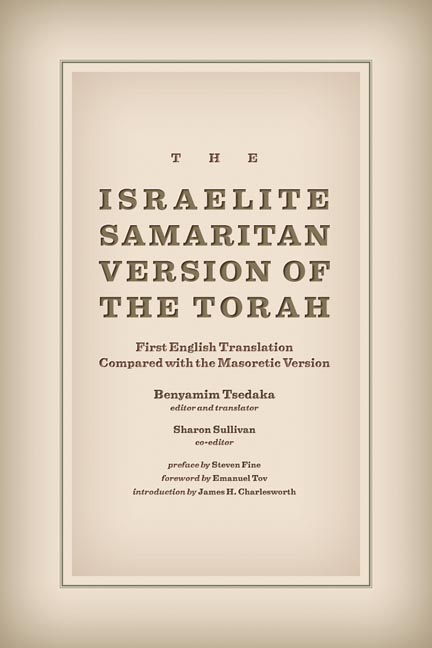
The
Israelite Samaritan Version of the Torah: First English
Translation Compared with the Masoretic Version
[Hardcover]
Sharon Sullivan (Editor),
Benyamim Tsedaka (Translator),
James H. Charlesworth (Introduction),
Emanuel Tov (Foreword) Pre-order now for $61.75 List
Price: $100.00 Wm. B. Eerdmans
Publishing Company (June 15, 2011)
http://www.amazon.com/Israelite-Samaritan-Version-Torah-Translation/dp/0802865194/ref=reg_hu-rd_add_1_dp_T2
~~~~~~~~~~~~~~~~~~~~~~~~~
The Last of the Samaritans
Reduced to 200
Persons, Remnant of Ancient Sect Which Regards Itself as The
True Following of Moses Lives On in Arab Palestine
The Milwaukee Journal – June 29, 1951 Robert T.
Hartmann, in a Nablus (Jordan) dispatch to the Los
Angeles Times.
The tall, white bearded patriarch, who
might have stepped out of an Assyrian bas-relief, was Mazliach
ben Pinchas, high priest of the Samaritans.
There are only about 200 representatives of
this ancient race left. They have kept their blood pure, though
terribly inbred, by marrying only among themselves for
centuries. This has led to a genetic twist producing a great
preponderance of boy babies, a condition difficult for the
casual visitor to discern since Samaritans of both sexes wear
their hair in unshorn curls. The dearth of females in the
Samaritan community makes them the only middle eastern people
who rejoice over the birth of a girl.
All of the surviving Samaritans live in
Nablus, a Moslem town of 22,000 about 80 miles north of
Jerusalem in the Jordan portion of Palestine. They find
themselves on good terms with their Arab neighbors because they
have been at odds with the Jews, whom they consider backsliders
from the true law of Moses, for nigh on 2,500 years. The feeling
today is as high as when Jeses chose the Good Samaritan to
illustrate the universality of kindness.
The modest Samaritan synagogue here is
one of the few remaining on the Arab side of the frontier. The
Samaritans believe themselves the real children of Israel and
their high priest, Mazliach, will trace his descent from Aaron
for you, if you have time.
If you have not, you are urged to take a
cup of coffee and a look at the Samaritan’s greatest treasure,
an ancient scroll of the Torah. Enclosed in a silver cylinder
and covered with a rich but worn brocade, this copy of the law
of Moses is among the oldest biblical manuscripts, but no price
or device has ever persuaded the impoverished Samaritans to part
with it.
The Samaritans acknowledge only the
Pentateuch (first five books of the Old Testament) and Joshua
and reject the rest of the Judaic canon. They claim their Torah
was inscribed by Abishua, a great-grandson of Aaron, in the 13th
century B.C. Most scholars are dubious, though acknowledging it
to be very old indeed.
The Samaritans’ austere place of worship
contains little more than the Torah, set on a rickety wooden
stand, rugs thrown about the floor, and along the walls a heap
of folded tents. These are used once each year when the entire
community camps atop near-by Mount Gerizim for the Passover.
Spotless lambs are sacrificed and eaten
on the mountaintop by the remnant of Samaritans exactly as their
ancestors have done for centuries. The temple that once stood
atop Gerizim and rivaled that of Jerusalem has been destroyed
since 130 B.C. The ruins of Samaria, ancient capital of Israel,
cover a hilltop not far from here. The pavements serve as a
threshing floor for Arab farmers. But the Samaritans remain
perfectly convinced that they alone are the elect of God.
Tourists are their only visible means of
support, and not many rich Americans come to see them any more.
The
High Priest in 1951 was Abrisha b. Phinhas b. Yittzhaq b.
Shalma
Mazliach is his Arab name.
~~~~~~~~~~~~~~~~~~~
Update on the Letter by the Editor
In the last Samaritan Update, we had a section on a Letter of the Samaritans of India
to those of Nablous found in the book,
Journal of a Tour in the Holy Land in May and June, 1840
by
Lady Francis Egerton.
We decided to find out more information, asking Benny Tsedaka
for his help. He was very interested and responded with the
following email. We understand that he is a busy man and as soon
as we learn more we will post the information.
~~~~~~~~~~~~~~~~~~~
THE SCOTTISH GEOGRAPHICAL MAGAZINE
Published by the Scottish Geographical
Society and edited by Hugh A. Webster and Arthur Silva White,
Volume II: 1886 Edinburgh, Printed by T. and A. Constable,
Printers to Her Majesty, At the University Press 1886
(p. 739) PROCEEDINGS OF THE SCOTTISH GEOGRAPHICAL
SOCIETY.
The Annual Business Meeting of the
Society was held in the Hall of the Merchants’ Company,
Edinburgh, on Thursday, 18th November- Dr. Hugh Cleghorn, Member of Council, presiding……..
(p.740)…..On the following evening, Sir
Charles Warren repeated his Address at the Opening Meeting of
the Glasgow Branch of the Society, in the Queen’s Rooms,
Glasgow. Mr. W. Renny Watson, the Convener of the Local
Committee, presided….
An interesting discussion followed the
paper by Sir Charles Warren….
(p741)In reply to a question by Mr. J.R.
Miller, Sir Charles Warren said that the greater portion of the
land belonged to the Government, who let it out, requiring in
return portion of the produce. As one passed through the plains
one would find the corn lying in heaps on the threshing-floors.
If one asked why they did not gather it, one would be told that
they were waiting till the Government inspector came for his
share; and it was a very large share. The people were very
improvident on account of the insecurity of tenure, and very
often they had no corn to sow. The consequence was that there
were people who lent corn on the understanding that they got
one-half of the produce, and the result was that in many
villagers after the corn was divided, a very small portion went
back to the villagers, so much so that it was insufficient to
keep them during the year, and when the sowing time came round
they had to go to the lender again. In reply to a further
question, Sir Charles said that the forms in the Samaritan
Passover were similar to those described in the Bible. Then
sheep were killed in a particular way; a portion was thrown
away. Then each sheep was fastened to a piece of wood, - a sort
of spit. Next a hole was dug in the earth, 7 feet deep and 3
feet across. A quantity of burning fuel was put down, and when
the sides of the hole were well heated, the pieces of wood with
the sheep attached were lowered into it, and left until the
sheep were pretty well roasted. At a certain hour at night they
took them out and ate the Passover. Some pieces were well done,
some ill done, and some very much burned.
The discussion was then closed.
The Scottish Geographical Magazine,
~~~~~~~~~~~~~~~~~~~
Links




